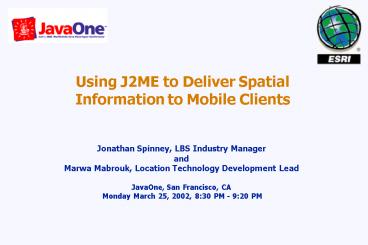LBS Architecture Model - PowerPoint PPT Presentation
1 / 21
Title:
LBS Architecture Model
Description:
The global leader in Geographic Information Systems (GIS) software ... Directory: Proximity and Pin Point. Location Utilities: Geocoding and Reverse Geocoding ... – PowerPoint PPT presentation
Number of Views:426
Avg rating:3.0/5.0
Title: LBS Architecture Model
1
Using J2ME to Deliver Spatial Information to
Mobile Clients
Jonathan Spinney, LBS Industry Manager and Marwa
Mabrouk, Location Technology Development Lead
JavaOne, San Francisco, CA Monday March 25,
2002, 830 PM - 920 PM
2
ESRI Inc. Profile
- Privately Held, founded in 1969
- The global leader in Geographic Information
Systems (GIS) software
- Headquartered in Redlands, California, USA
- Proven GIS solutions for over 25 sectors of
business application
- 10 domestic U.S. offices
- 90 international offices and affiliates
- More than 2,500 staff members worldwide
- Year 2001 revenues of more than 427 million
3
Presentation Overview
- LBS Architecture
- LBS Services
- Why J2ME for Location-based Services (LBS)?
- A Survey - Is there a need for J2ME in LBS?
- Whos using J2ME for LBS?
- ESRI J2ME Activities
- Example J2ME Application
- Live Demo and QA
4
LBS Architecture Overview
5
LBS Services Overview
http, XML
6
Core LBS Services
- Location Utilities Geocoding and Reverse
Geocoding
- Directory Proximity and Pin Point
- Navigation
- Tracking
- Mapping and maps
- Gateway (mobile device positioning)
7
Hosting and Consuming GIS Web Services with J2ME
- GIS web services ESRIs Geography Network
- HTTP accessible services
- XML Interfaces
- J2ME Clients
- Service Proxies and User Interfaces for consuming
GIS web services
8
Why J2ME for Location-based Services?
- WAPs gopher-style browser is now regarded as an
aging technology likely to fail as next
generation wireless applications such as LBS
demand more robust UIs and functionality.
- Spatial data and LBS, along with gaming and
multimedia services, demand robust UIs in order
to be useful for the average mobile consumer
- LBS require map rendering capabilities. WAP only
supports static wbmps, which arent very good
visual representations
- Interactive, customized J2ME MIDlets empower LBS
users to dynamically pan, zoom, and query locally
cached spatial data downloaded over-the-air to
mobile devices.
- J2ME is scalable, open, OS independent, and
forward compatible with J2SE/EE.
9
Is there a need for J2ME in LBS? A Survey
10
Is WAP adequate for wireless web services like
stocks, news, and weather?
11
Will WAP 2.0 provide improved functionality for
the wireless web and Location-based Services?
12
Are LBS a mobile application driving more robust
functionality at the mobile client level?
13
Wireless Respondent Types
14
Professional Classification Types
15
Whos using/promoting J2ME for LBS?
- Standards Organizations
- Third Generation Partnership Project (3GPP), a
group responsible for defining the specification
for the next-generation handset application
environments, have identified J2ME as the
industry standard for mobile devices and 3G
wireless applications.
- Mobile Device Manufacturers
- Ericsson, NEC, Nokia, Palm Computing, Research In
Motion (RIM), LG TeleCom, Samsung, and Motorola
have all shipped Java-ready MIDP devices.
- Wireless Network Operators
- Devices by the above manufacturers supporting
MIDP work on all major wireless networks.
Network types include GSM (GPRS, EDGE), PDC,
iDen, CDMA, TDMA, CDMA2000, and UMTS. Some
Operators (e.g. Sprint PCS, Nextel, NTT DoCoMo)
have launched J2ME application developer
programs.
16
ESRI J2ME Activities
- ESRI has currently developed direct support for
Windows CE in ArcPada more robust offline mobile
GIS vs. an LBS.
- ESRI have extended the mobile client offering
through our business partners. These offerings
include one-off J2ME MIDlets for concierge and
navigation services.
Win CE
- MIDlets offer OS/device-independent mapping
functionality, and they are able to consume GIS
web services.
- MIDlets standard mapping features include zoom,
pan, and local cache for offline operations.
17
Example J2ME Application Courtesy of ESRIs
Business Partner AirZip
18
Get Map Function
- User initiates the Get map function
- User Enters an address or is automatically
positioned by the network
- User receives the map from the server
19
Find Business Function
- User may next view POI sub-categories
- User may then choose specific POI
- User receives attributes of preferred POI
destination
- After location is determined, user is presented
with POI categories
20
Find Route to Destination Function
- Directions are displayed in textual format and
user can toggle between the map and route
- After preferred POI is determined, user may
initiate the get directions function
21
Live Demo and QA































